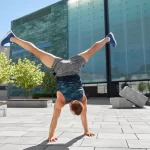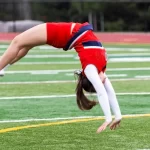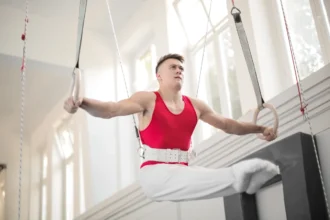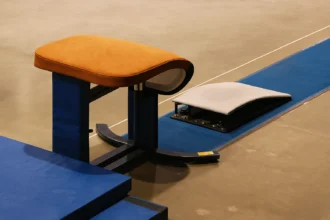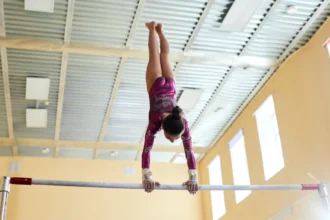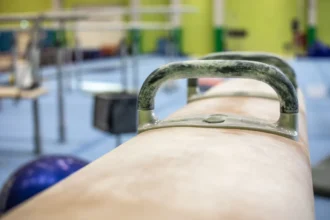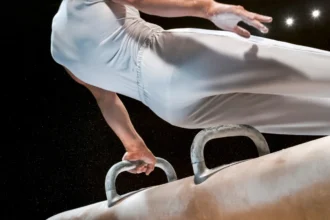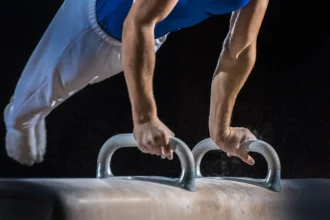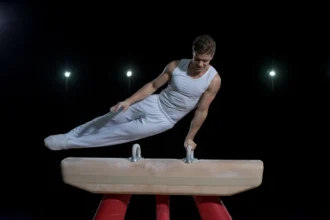Simone Biles isn’t just a gymnastics legend—she’s a pioneer who’s redefined what’s possible in the sport. The vaults, floor routines, and balance beam dismounts that bear her name have set new benchmarks for the sport.
| Move | First Performed | Event | Difficulty Score | Difficulty Level |
|---|---|---|---|---|
| The Biles (Vault) | 2018 | 2018 World Championships | 6.4 | G (Advanced) |
| The Biles II (Vault) | 2023 | 2023 World Championships | 6.6 | H (Very Advanced) |
| The Biles (Floor) | 2013 | 2013 World Championships | 5.6 | F (Advanced) |
| The Biles II (Floor) | 2019 | 2019 World Championships | 6.6 | J (Extreme) |
| The Biles (Balance Beam) | 2019 | 2019 World Championships | 6.3 | H (Very Advanced) |
Let’s take a closer look at Simone Biles’ five signature moves and why they’re so groundbreaking.
1. The Biles (Vault)
The Biles Vault is one of the most difficult and visually stunning vaults in gymnastics. The vault involves a roundoff entry onto the vault table, a half twist, and a front double full somersault off the vaulting table. The sheer difficulty of this move, combined with its fluid execution, makes it one of the most impressive vaults in gymnastics history.
First Performed:
- Date: 2018
- Event: 2018 World Championships
- Difficulty Score: 6.4
- Difficulty Level: G (Advanced Difficulty)
Steps:
- Roundoff Entry: The gymnast begins by performing a roundoff (similar to a cartwheel) onto the vault table. This creates the necessary momentum and body alignment to execute the complex elements that follow. A strong roundoff sets the foundation for the vault’s success.
- Half Twist: After the roundoff, the gymnast performs a half twist (180 degrees) in the air, just before launching off the vaulting table. This twist requires excellent air control and positioning.
- Front Double Full Somersault: The gymnast performs two front somersaults with two full twists. This phase requires extreme core control and strength to keep the body aligned while ensuring a high, controlled rotation.
- Landing: The gymnast must land cleanly, with excellent control and stability, after completing the flips and twists. The landing is one of the most challenging parts of the skill, requiring precise timing to avoid deductions.
Difficulty Analysis:
The Biles Vault is one of the hardest vaults in gymnastics. The combination of a half twist and a double somersault requires exceptional control and timing, especially mid-air. The most challenging part is maintaining air awareness to execute the front flips and twists while ensuring the body stays aligned for a smooth landing. With its difficulty score of 6.4, the vault sets a high bar in elite gymnastics.
2. The Biles II (Vault)
The Biles II Vault is an evolution of the original Biles vault, raising the difficulty level even higher. This vault follows a Yurchenko-style entry and requires extreme strength, precision, and control in the air. After the roundoff onto the vault table, the gymnast performs two flips in a pike position, making this vault even more challenging than the original Biles Vault.
First Performed:
- Date: 2023
- Event: 2023 World Championships
- Difficulty Score: 6.6
- Difficulty Level: H (Very Advanced Difficulty)
Steps:
- Yurchenko Entry: The gymnast begins with a Yurchenko-style roundoff onto the vaulting table, followed by a strong block to generate both height and rotational power.
- Two Flips in Pike Position: After the block, the gymnast performs two flips in a pike position (legs straight, body folded). The pike position makes the skill more difficult due to its tighter body shape and reduced air resistance, requiring even more control and strength.
- Landing: As with all vaults, landing cleanly is essential to avoid deductions. The gymnast must execute the flips with precision and land with stability and control.
Difficulty Analysis:
The Biles II Vault is even more challenging than the original because of the added difficulty in the pike position. The gymnast needs to maintain tightness throughout the flips to avoid losing control or slowing down the rotation. With a difficulty score of 6.6, this vault pushes the limits of what’s possible on vault, and very few gymnasts can perform it at the elite level.
3. The Biles (Floor Exercise)
The Biles on Floor is a stunning tumbling pass considered one of the most difficult and impressive moves in gymnastics history. This skill consists of a double layout (two backflips in a straight body position) with a half twist added to the second flip. The combination of power, speed, and fluidity required to execute the Biles makes it one of the hardest skills on floor exercise.
First Performed:
- Date: 2013
- Event: 2013 World Championships
- Difficulty Score: 5.6
- Difficulty Level: F (Advanced Difficulty)
Steps:
- Double Layout: The gymnast begins the tumbling pass with a double layout, which involves two backflips performed in a straight body position. This requires immense air time, speed, and control.
- Half Twist in the Second Flip: After completing the first flip, the gymnast adds a half twist to the second flip. This twist is challenging because it must be executed in mid-air, requiring impeccable timing and air awareness.
- Controlled Landing: The skill concludes with a clean landing. The gymnast must control their balance and maintain precision despite the complexity of the move.
Difficulty Analysis:
The Biles on Floor is one of the toughest skills on floor exercise due to the combination of a double layout and a half twist. The gymnast must generate enough power for height while ensuring the body remains aligned throughout the tumbling pass. With a difficulty score of 5.6, this move is among the hardest but remains manageable for top-level gymnasts.
4. The Biles II (Floor Exercise)
The Biles II on Floor is one of the most difficult elements ever performed, involving a triple-twisting double backflip. This skill combines an extreme number of flips and twists, making it one of the most technically demanding skills in gymnastics.
First Performed:
- Date: 2019
- Event: 2019 World Championships, Stuttgart, Germany
- Difficulty Score: 6.6
- Difficulty Level: H (Very Advanced Difficulty)
Steps:
- Double Backflip: The gymnast performs two backflips in quick succession. The execution must be fast, with perfect timing to ensure the body rotates smoothly.
- Triple Twist: The gymnast then performs three twists during the second backflip. This adds immense difficulty and requires supreme control to ensure that the twists are executed without losing form.
- Landing: Landing after such a complex move is incredibly challenging. The gymnast must focus on spotting the floor and controlling their descent for a clean and stable landing.
Difficulty Analysis:
The Biles II on Floor is a massive leap in difficulty due to the triple twist and the fact that it’s done in a double backflip. The gymnast needs to be strong, precise, and incredibly aware of their body in the air to successfully complete all three twists. With a difficulty score of 6.6, it’s one of the most difficult tumbling passes to execute in gymnastics, and only a few gymnasts are capable of performing it to perfection.
5. The Biles (Balance Beam)
The Biles on Balance Beam is one of the most groundbreaking skills in the sport. This dismount, a double-twisting, double backflip, is the most difficult dismount ever attempted on the beam. It requires incredible precision, timing, and control, making it one of the most impressive skills in gymnastics.
First Performed:
- Date: 2019
- Event: 2019 World Championships, Stuttgart, Germany
- Difficulty Score: 6.3
- Difficulty Level: G (Advanced Difficulty)
Steps:
- Preparation and Takeoff: The gymnast approaches the end of the balance beam with steady momentum. Proper positioning and body alignment are crucial for the dismount.
- Double Backflip: The gymnast performs two backflips in the air, maintaining a tight and controlled form. The challenge lies in executing the flips perfectly due to the limited space on the beam.
- Double Twist: While completing the second backflip, the gymnast adds two full twists. This part of the skill requires precise timing and air control to execute both flips and twists correctly.
- Landing: A precise, controlled landing is essential. The gymnast must maintain balance and avoid any additional movements after landing to ensure a high score.
Difficulty Analysis:
The Biles on Balance Beam is one of the highest-difficulty moves ever attempted on the beam. The complexity lies in executing a back handspring directly into a double backflip with two full twists while balancing on the narrow beam. With a difficulty score of 6.3, this move challenges the gymnast’s coordination, air awareness, and balance.



